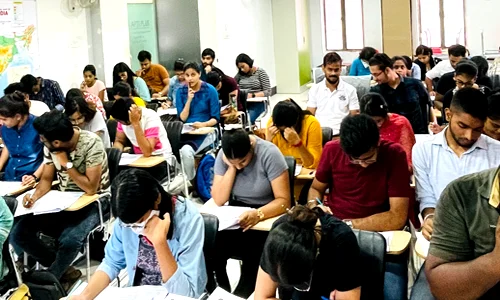



India’s post-Independence economic journey moved from slow, state-led growth to market-driven expansion. The phrase “Hindu rate of growth,” coined by economist Raj Krishna, described India’s stagnant average growth of roughly three to three-and-a-half percent between the nineteen fifties and seventies. However, growth began accelerating from the early nineteen eighties, well before the nineteen ninety-one reforms, as selective liberalisation and industrial capacity building improved productivity. The reform wave of nineteen ninety-one deepened this shift, while the two thousand three to two thousand eleven phase delivered high growth of eight to nine percent. Since then, India has faced moderation linked to global headwinds, financial stress and the pandemic, yet it remains the fastest growing major economy. Thus, India has long surpassed the so-called Hindu rate of growth, evolving from a low-growth economy to one increasingly driven by reform, capability building and structural transformation.
Click to View MoreThe RBI’s 25 bps repo rate cut to 5.25% reflects confidence in low inflation and strong growth, aiming to boost borrowing, investment and consumption through cheaper credit. While it supports economic momentum, risks persist due to rupee weakness and uncertain external conditions, making cautious monetary calibration essential.
Click to View MoreA G20 report by the World Inequality Lab warns that India’s wealth is heavily concentrated, with the top 1% holding 40.1% of national wealth while the bottom half owns only 6.4%. It urges G20 nations to impose a 2% global minimum tax on billionaires to curb inequality.
Click to View MoreIn October 2025, India’s Goods and Services Tax collections reached ₹1,95,936 crore, up 4.6% from the previous year, partly due to festive spending. GST, introduced in 2017, replaced multiple indirect taxes to create a unified system. While industrialized states like Maharashtra, Karnataka, Gujarat, Tamil Nadu, and Haryana contributed over 40% of revenue, 20 states saw declines compared to pre-GST levels. Analysis shows that overall GST revenue remains lower than pre-GST taxes, with states like Mizoram and Nagaland improving collections, while Punjab, Chhattisgarh, Karnataka, Madhya Pradesh, and Odisha experienced significant drops.
Click to View MoreForeign Portfolio Investors (FPIs) are key players in India’s capital markets, providing liquidity and linking the country to global finance. Recent data shows a massive FPI sell-off of ₹1.5 lakh crore in 2025, driven by tepid corporate earnings, high valuations, and global economic uncertainties. Such outflows impact market stability, exchange rates, and investment sentiment, highlighting the need for stronger corporate performance, policy reforms, and investor-friendly measures to restore confidence and attract sustainable foreign investment.
Click to View MoreIndia aims to become a $30 trillion economy in the next 25 years, driven by sustained GDP growth, strategic government policies, and long-term planning. While past growth trends and currency factors make this projection plausible, challenges such as slowing growth rates, inflation, and infrastructure gaps remain. Achieving this goal will require multi-dimensional efforts in trade, investment, technology, and human capital development, positioning India as a major global economic power by 2050.
Click to View MoreThe US Federal Reserve recently cut its key interest rate by 0.25%, signaling two more cuts this year to support its slowing labor market. This move impacts India by influencing capital flows, currency value, borrowing costs, and inflation. While lower global rates can boost growth and investment, India faces risks like currency volatility, imported inflation, and banking sector stress. A balanced approach with monetary policy, fiscal prudence, and structural reforms is essential to leverage opportunities while safeguarding economic stability.
Click to View MoreIndia’s Index of Industrial Production (IIP) slipped to a three-month low of 4% in September 2025, reflecting slow growth in mining, primary goods, and consumer non-durables sectors. While consumer durables and manufacturing saw improvement due to GST reforms and festival demand, the overall industrial activity in the first half of FY 2025-26 was the slowest in five years. Government measures like GST rate cuts, PLI schemes, MSME credit support, and infrastructure development aim to revive growth. A holistic approach involving investment promotion, modernization, skill development, and policy stability is critical to sustain industrial growth and boost economic resilience.
Click to View MoreIndia’s public debt, currently around 57% of GDP, has been rising due to persistent fiscal deficits, growing welfare and infrastructure spending, and higher interest costs. High debt limits fiscal flexibility, increases taxpayer burden, and can slow economic growth. The government is addressing this through fiscal consolidation, tax reforms, optimized expenditure, and debt management strategies, aiming for a sustainable debt-to-GDP ratio of 50% by FY31 while supporting economic growth.
Click to View More
NITI Aayog's Women Entrepreneurship Platform (WEP) launched the 'WE Rise Initiative,' marking a powerful push for women's economic empowerment. Designed around the 'Three Ps'—Patronage, Partnership, and Practice—this digital platform provides customized mentorship and financial linkage to high-potential women-led enterprises.
Click to View MoreThe Biotech sector in India is experiencing rapid growth, fueled by innovation, government initiatives, and international demand. However, challenges such as funding shortages, fragmented infrastructure, and outdated regulations impede its full potential. To become a global leader, India must streamline biotech clusters, attract late-stage investment, update regulations, and develop skilled talent for sustainable, innovation-driven growth.
Click to View MoreThe 2025 Economics Nobel honored Joel Mokyr for showing sustained growth needs a constant feedback loop between theoretical and practical knowledge, mass skilling, and societal openness. Philippe Aghion and Peter Howitt formalized Creative Destruction, demonstrating that temporary monopoly power fuels competitive, cyclical innovation and progress.
Click to View More
© 2025 iasgyan. All right reserved